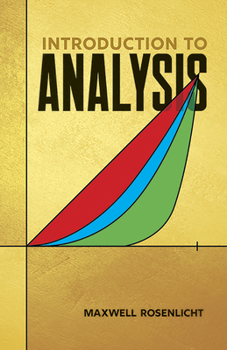Introduction to Analysis
Select Format
Select Condition 
Book Overview
This well-written text provides excellent instruction in basic real analysis, giving a solid foundation for direct entry into advanced work in such fields as complex analysis, differential equations, integration theory, and general topology. The nominal prerequisite is a year of calculus, but actually nothing is assumed other than the axioms of the real number system. Because of its clarity, simplicity of exposition, and stress on easier examples,...
Format:Paperback
Language:English
ISBN:0486650383
ISBN13:9780486650388
Release Date:January 1986
Publisher:Dover Publications
Length:272 Pages
Weight:0.61 lbs.
Dimensions:0.5" x 5.3" x 8.5"
Related Subjects
Calculus Education Education & Reference Math Mathematics Pure Mathematics Science & MathCustomer Reviews
5 ratings
Great book
Published by Thriftbooks.com User , 18 years ago
I don't know about you, but I'm not a fan of large books. His presentation is terse, and very readable. I bought this for self study and was initially concerned with the lack of solutions. But as I continued my studies I actally found it aided learning, I stuck through problems that I would have normally just looked up the solutions for. If you want to teach yourself, its length and writing style is for you. My only complaint is the lack complex analysis, he does however present you with some of the basic results as exercises.
still one of the best
Published by Thriftbooks.com User , 21 years ago
The book was written in 1960s, and is still one of the best. The presentation is exceptionally clear; treatment of metric spaces and elementary topology is superb. Plenty of counterexamples and good (doable) exercises (some with useful hints). The print is a bit small, but you'll get used to it. Worth every penny. More math texts should be as short, inexpensive and good as this one. Highly recommended.
a bargain
Published by Thriftbooks.com User , 23 years ago
Buying this book is a no-brainer. It's only [price]. Unlike many dover books, it's not a reprint of a hundred year old text or dominated by 19th century style formal manipulations with indices running everywhere and no actual analysis or rigorous proofs. It covers the key topics of elementary real analysis (ie advanced calculus, or calculus with real proofs), which is basic to almost all fields of mathematics. In order to focus on the main ideas and definitions, it leaves out many topics and definitions (like functions of bounded variation, absolute continuity, lebesgue integration, differential forms, lebesgue covering lemma, f.i.c. etc.), so you should definitely have a more complete and comprehensive text like Apostol or Rudin (I prefer Apostol, although Rudin has complementary strengths). But for those omissions, Rosenlicht is quite a bit more readable than Apostol, which is best worked through methodically (since it contains a lot of results explicitly presented, its primary strength). Because it's both short and readable and focused, you can get through it reasonably quickly. Modern secondary school education teaches students to skip over the cursory material on elementary set theory, number systems, and strangely named but apparently obvious concepts like associativity and other field axioms, and to jump straight to the various sections with formulas in outlined boxes and procedure recipes for performing calculations. These rote recipes typically lack any conceptual unity and students are not often worse for wear forgetting or only superficially grasping previous ideas. This is a good way to never actually learn any legimate mathematics. Real math works on the principle of A->B->C->.... A proof (or your understanding of a mathematical concept) is only as strong as the weakest link in a chain. Learn and forget is not an adequate way to study math, and that's why introductory analysis is usually the course which weeds out those who will be able to explore the wider ocean of mathematical knowledge, and those for whom mathematics will be forever a giant forbidding question mark. The reality is, any above average person with the will, patience and time can learn this material and find themselves looking back thinking "Why was that so hard?" Blame it on the shabby state of secondary education. Do not skip over or gloss over the material on the real numbers if you aren't already fully conversant with the notion of l.u.b. and facile with its application (in which case why are you reading this book?). The l.u.b. property of the reals is your first real weapon to actually prove elementary theorem's of Calculus. Anyway this book isn't perfect, it's only good as an intro. and not a reference, but it serves the purpose of being accessible while still covering the key ideas and packing enough wallop to the requisite math whupping required by students numbed by years of inadequate secondary school education and the typical mechanical treatment of calculu
Gets right to the point with no waste of time!
Published by Thriftbooks.com User , 26 years ago
In the beginning the faint of heart should beware. This book takes no time in getting to the deeper underpinnings of analysis. This makes the reader learn and become comfortable far quicker then the average book, although it can be frustrating for the first month. However, past the introduction, Rosenlicht gives an unmatched exposition of difficult material and is far more readable than most. Definately the best book in analyis for the money! Great as a stand alone text or as a supplement to a beginners course in analysis such as Russell Gordon, "Real Analysis: An Introduction." Every student should own a copy (is $8 all that much?)
An excellent introduction to real analysis
Published by Thriftbooks.com User , 26 years ago
A very readable book. Any student with two years of calculus should be able to read this with understanding. Starts with metric spaces, and proceeds through differentiation, integration, interchange of limits, implicit functions. A kinder and gentler introduction, yet rigorous.





